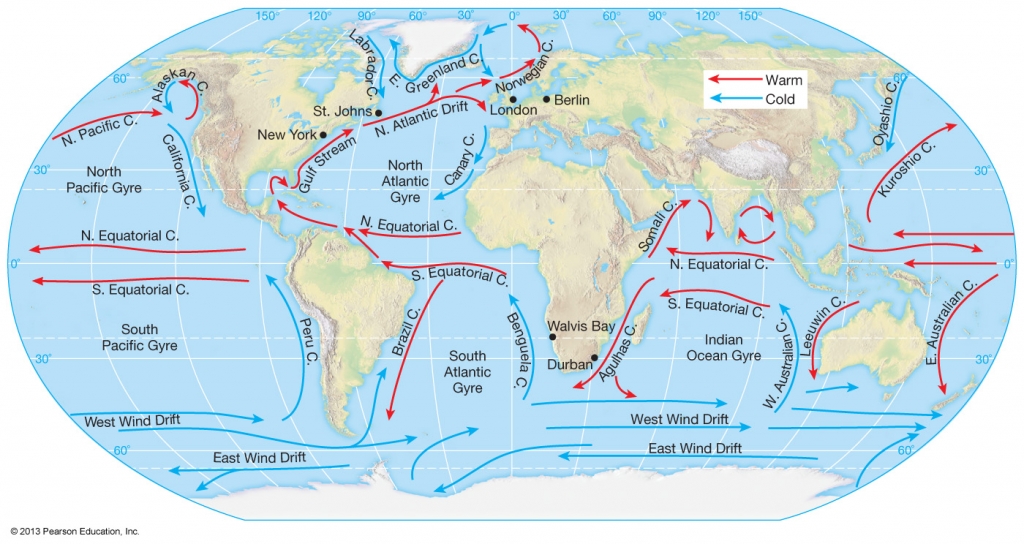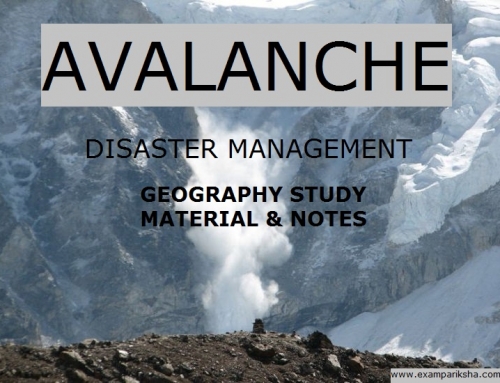Since the ocean waters are dynamic, it shows two types of movements:horizontal and vertical. This movement of ocean water is influenced by a variety of factors like
- Its physical characteristics – temperature, density, salinity
- External forces – Sun, moon, and winds
I. The two types of Horizontal motion of movements of ocean water –
- Ocean Current: Move water from one place to another. It is the continuous flow of large amount of water in definite direction.
- Waves: Water does not move, wave train does in horizontal motion.
II. There are types of Vertical motion(rise and fall of water in oceans and sea) of ocean water –
- Tides: occur due to attraction of the Sun and Moon, water is raised up and falls down twice a day.
- Upwelling of cold water from subsurface
- Sinking of surface water
<< Read about the Fundamental Rights under Indian Constitution>>
Wave movement of ocean water
Waves travel because wind pushes the water body in its course while gravity pulls the crest of waves downwards. Steep waves are young – local winds. While slow and steady waves have their origin far, sometimes in another hemisphere.
The actual motion of water beneath the waves is circular. Wind provides energy to the waves. The energy is released on shorelines.
Tides in Ocean water
The periodical rise and fall of sea level, once or twice a day, mainly due to attraction of Sun and Moon is known as a tide.
Surge: Movement of water cased by meteorological effects (winds and atmosphere changes). Not regular.
Causes: Moon’s gravity pull(major) and Moon’s gravity pull is (minor)
Centrifugal force : acts to counter balance the gravity of moon.
Tide- generating force: difference between two forces – gravitational attraction of moon and centrifugal force. From tidal bulges on two sides of Earth.
Tidal Currents – When the tide is channelled between islands or into bays and estuaries.
Highest Tides – Bay of Fundy, Canada.
Types of tides: based on frequency of occurrence .
A. Semi-diurnal tide: are most common. There are two high tide and two low tide each day . All of them are of approximately same height.
B. Diurnal tide: one high tide and one low tide during each day.
C. Mixed tide: With varied height tides. Along west coast of North America, many islands of Pacific Ocean.
Based on Sun, moon and Earth’s positions, types of tide:
A. Spring tides: Higher tide. Occur twice a month on full moon, new moon. When Sun, moon and Earth in straight line.
B. Neap tides: Lower tides. Occurring at seven day interval between spring tides and neap tides. Sun and Moon at right angle to each other forces act counter on another.
Terminology related to tides:
- Ebb: Time between high tide and low tide, when water level is falling.
- Flow or flood: Time between low tide and high tide when water level is rising.
- Perigee: Moon closest to Earth once a month unusually high and low tides occur.
- Apogee: Two weeks later, moon is farthest from Earth, tidal ranges become less than average.
- Perihelion: Earth is closest to Sun on 3 Jan, tidal ranges are very high and low.
- Aphelion: Earth is farthest from Sun on 4 July, tidal ranges are less than average.
<< Read about the Kushana Empire here>>
Importance of Tides:
- Navigation: Can be predicted in advance, help sailors plan their activities.
- Tidal heights: Harbours near rivers and within estuaries having shallow bars at entrance, which prevent ships and boats from entering into harboour.
- Desilting the sediments and removing polluted water from estuaries.
- Used to generate electrical power: The 3 MW tidal power project at Durgaduani in Sundarbans of West Bengal is under way.
Ocean Currents
It is like river flow in Oceans. Ocean Currents represent a regular volume of water in a definite path and direction. They are influenced by two types of forces:
- primary forces that initiate the movement of water.
- secondary forces that influence the currents to flow.
Primary Forces that initiate the movement.
- Heating by solar energy: Water expands, therefore near equator ocean water is 8 cm higher in level than in the middle latitudes. Slight gradient and water flows down the slope.
- Wind: Blowing on surface pushes the water.
- Gravity: Tends to pull down the pile and create create gradient variation.
- Coriolis force: Causes water to move to right in Northern hemisphere. and to left in southern hemisphere.
Gyres: large accumulations of water and the flow around them. Produce large circular currents in all the ocean basins.
Secondary forces that influence the currents to flow are:
Difference in water density affects vertical movement of ocean water currents. High salinity water is denser. Cold water is denser than warm water. Denser water tends to sink. Cold water currents occur when cold water at poles sinks and slowly moves towards the equator. Warm water currents travel from the equator along the surface, flowing towards the poles to replace sinking cold water.
<< Read about list of important days and dates here>>
Types of Ocean Currents
Based on their depth:
I. Surface Currents: They comprise of 10% of total water current. They occurr in upper 400m.
II. Deep Ocean currents: 90% of ocean water, moving around ocean basin due to variation in density and gravity.
Based on temperature:
I. Cold Current: Bring cold water into warm water areas. West coast of continents in low or mid latitudes in both hemispheres. East Coast in the higher latitudes in the Northern hemisphere.
II. Warm current: They bring warm to cold water areas. Low and middle latitude’s east coast in both hemisphere. In Northern hemisphere, they are found in west coast in Northern hemisphere.
Effects of Ocean Current Movement:
- West coast of continents in tropical and sub-tropical latitudes(except equator) are bordered by cool waters. Average temperature low, narrow diurnal and annual ranges.
- West coast of continents in mid & higher latitudes are bordered by warm water- cause a distinct marine climate. Cool summer and mild winters, narrow annual range of temperature.
- Warm currents flow parallel to East Coast of continents in tropical and sub-tropical latitudes. Warm and rainy climate. Western margins of Subtropical anti-cyclones.
- Mixing Zones: Best fishing grounds of world. Mixing of warm and cold current replenish oxygen and favour plankton growth which is the primary food for fishes.





